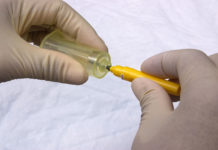
The yellow pigment bilirubin that is associated with jaundice may have a role in protecting the heart
Moderation, they say, is the key and so it is – at least when it comes to bilirubin. The pigment that is known by its association with jaundice when its levels are raised, may also have a protective effect in the heart.
Bilirubin, a yellow-orange pigment, is formed after the breakdown of red blood cells and is eliminated by the liver. It’s not only a sign of a bruise, it may provide cardiovascular benefits, according to a large-scale epidemiology study.
A recent analysis of health data from almost 100,000 veterans, both with and without HIV infection, found that within normal ranges, higher levels of bilirubin in the blood were associated with lower rates of heart failure, heart attack and stroke.
The results have been published in the Journal of the American Heart Association.
Several studies have suggested that bilirubin may have beneficial effects, by acting as an antioxidant or interfering with atherosclerosis.
The data from the veterans adds to this evidence, and specifically looks at people living with HIV and at an anti-HIV drug, atazanavir, known to elevate bilirubin. The researchers did not see an independent effect of atazanavir on cardiovascular risk.
Higher levels of bilirubin meant lower risk of heart attack, heart failure or stroke. The group with the highest level of bilirubin had 76 percent of the risk for combined cardiovascular events
Even if well-controlled by antiretroviral drugs, HIV infection has negative effects on cardiovascular health, says lead author Vincent Marconi, MD.
“We initially wanted to see if bilirubin and cardiovascular disease had a different relationship in people who were HIV positive, compared to HIV negative,” says Marconi, professor of medicine and global health at Emory University School of Medicine and Rollins School of Public Health. He is also director of infectious disease research at the Atlanta Veterans Affairs Medical Center.
Study authors include VACS principal investigator Amy Justice, MD, PhD from Yale, Matt Freiberg, MD and others from Vanderbilt, Jeff Lennox, MD from Emory and additional investigators from Vanderbilt, Boston University, Penn, Pitt, UCLA and Baylor.
Marconi and his colleagues examined data from the Veterans Aging Cohort Study, a nationwide look at HIV infection, supported by the National Institutes of Health. VACS data included 31,418 HIV-positive and 66,987 HIV-negative veterans, almost all men and 48 percent African American. Their age was an average of 48 years.
The researchers divided study participants into four groups according to their bilirubin levels.
Higher levels of bilirubin meant lower risk of heart attack, heart failure or stroke. The group with the highest level of bilirubin had 76 percent of the risk for combined cardiovascular events as the group with the lowest level, with effects seen even in people without liver disease.
“Large increases in bilirubin were not required to see an effect on CVD risk reduction,” Marconi says. “Most of the change happened well within the normal physiologic range and specifically from the first to the second quartile.”
The authors concluded: “This work provides epidemiologic rationale for future studies to investigate how the antioxidant effect of bilirubin could be harnessed to reduce chronic disease morbidity risk. Future studies should explore the use of bilirubin as a biomarker for other inflammation mediated conditions and all-cause mortality.”












